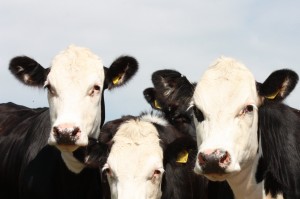Cattle Diseases
Pink Eye in Cattle
Also known as: Conjunctivitis, New Forest Eye, Infectious Bovine Keratoconjunctivitis, Keratoconjunctivitis
Pink Eye is also called Infectious Bovine Keratorconjunctivits (IBK), Silage eye, or conjunctivitis and is one of the most common diseases of cattle. The disease has a world-wide distribution and is usually seen in epidemics when a chronically or subclinically infected animal enters a herd. The clinical symptoms vary depending on the animal’s susceptibility and other contributing factors such as environment, season and strain of bacteria (McConnel et al., 2007) but the main symptoms are runny eyes, red and inflamed conjunctiva and corneal ulcers in the later stages of infection. Tremendous economic losses stem from inappetance and poor weight gain in affected animals suffering from ocular pain and visual impairment (McConnel et al., 2007).
The causative agent is a bacterium Moraxella bovis although this organism is not isolated from every case, and unaffected carrier animals are also found (Watson, 2004). The condition is seen commonly during the summer months. It is suspected that ultraviolet light, dust, face fly population, concurrent pathogens, climate, and pasture conditions act as predisposing factors (Baptista, 1979; Watson, 2004). Young animals are more susceptible than older animals and exhibit more severe clinical symptoms, which can lead to significant depression of growth (Snowder et al., 2005). Most clinical cases are seen in animals less than two years of age (Webber and Selby, 1981).
Keratoconjunctivitis has also been reported where Chlamydia spp were isolated as the possible cause (Otter et al., 1995). This should be considered if cases are widespread, severe and long lasting, and may be of significance as a zoonotic disease. Inflammation of the eye can also be caused by Listeria monocytogenes of silage origin, resulting in silage eye, although this is differentiated from IBK in that silage eye affects primarily the iris and does not commonly lead to corneal ulceration and a positive fluorescein reaction such as is seen in IBK.
Control and Prevention of Pink Eye
Preventative measures that reduce predisposing factors such as dust and corneal irritation and the provision of shade have been suggested (Watson, 2004). Fly control may also be beneficial (Postma et al., 2008) , but it has been reported to not have a significant impact (Hall, 1984; Webber and Selby, 1981). Inadequate feeding space, leading to animals coming into very close contact during feeding, may enhance the spread of the disease within a herd.
Isolation and prompt treatment of affected animals is likely to reduce the spread of the disease.
Keeping the disease out of non-infected herds is the best prevention. Health records of herds that sell breeding animals should be checked for this condition. Quarantine of purchased animals to avoid including incubating individuals in the main herd should also be practiced.
There is no vaccine available for Pink Eye.
Treating Pink Eye
Treatment is with antibiotics administered either systemically or locally (topically or subconjunctivally). As the condition can be extremely painful, support therapy with anti-inflammatory agents, with either corticosteroids or non-steroid anti-inflammatory agents is commonly practiced and is recommended on welfare grounds. The efficacy of subconjunctival antibiotic treatment with penicillin has been questioned (Allen et al., 1995; Eastman et al., 1998; Sargison et al., 1996).
Pink Eye and Welfare
The condition is extremely painful and irritating and should be treated immediately to avoid further suffering and to prevent corneal ulceration in the advanced form of the disease.
Good Practise based on Current Knowledge
- Implement a closed herd policy
- If animals are introduced to the herd, quarantine them for a minimum of two weeks and check the herd of origin health records for incidence of Pink Eye
- Ensure the animals have adequate feeding space as to minimize contact and disease transmission
- Control flies efficiently, particularly among young stock
- Provide shade and minimize dust
- Treat and isolate affected animals immediately


 British English
British English



Comments are closed.